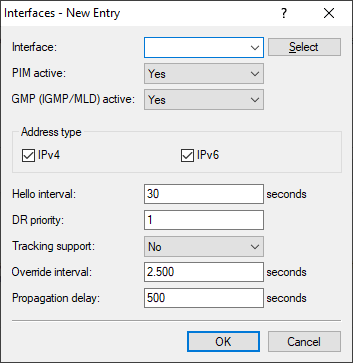In LANconfig you configure the interfaces under using Interfaces. This table specifies the interfaces and logical networks where PIM is to be enabled. It also specifies the interfaces where clients can join multicast groups by means of IGMP or MLD. An entry is required in the PIM interface table for every interface involved in multicast routing, including client interfaces and the source interface.

- Interface
- Name of the logical interface on which PIM or a GMP (group management protocol such as IGMP or MLD) is to be activated. Possible values are IPv4 networks, e.g. INTRANET, WAN remote sites, wildcard entries with * for IPv4 RAS interfaces, for example "VPN*". Other possible values are IPv6 interfaces and IPv6 RAS templates.
- PIM active
- Enables PIM as well as sending and receiving PIM messages on this logical interface. If this interface is only used by IGMP/MLD clients or multicast recipients, sending and receiving PIM messages can be explicitly disabled. In this case, only GMP (IGMP/MLD) has to be activated.
- GMP (IGMP/MLD) active
- Enables the IGMP or MLD router role on this logical interface. In this case, IGMP or MLD joins from clients are accepted. GMP can be disabled on interfaces where the network contains no clients but only PIM neighbor routers. IGMP/MLD joins will not be accepted in this case.
- Address type
- Here you specify the address family for which PIM or GMP should be enabled on this interface. If necessary, you can also activate both types of address at the same time. Possible values: IPv4, IPv6
- Hello interval
- Sets the time in seconds between the repetition of regular PIM Hello messages. The hold time is automatically 3.5 times the PIM Hello interval and cannot be configured separately. Possible values: 0-255 seconds, default: 30. The value 0 disables the sending of Hello messages.
- DR priority
- Specifies the priority as designated router (DR) in the DR election process in PIM. A higher value means a higher priority in the DR election. If several routers have the same (highest) priority, the router with the highest numeric IP address will be the DR. Possible values: 0 bis 232, default: 1.
- Tracking support
- Affects the "T bit" setting in the LAN Prune Delay option in outgoing Hello messages. Possible values: Yes, No, default: No.
- Override interval
- Affects the setting of the override interval field in the LAN Prune Delay option in outgoing Hello messages. Specifies the maximum delay for transmitting Override Join messages for multicast networks that have Join-Suppression enabled. Possible values: 0 bis 232, default: 0.
- Propagation delay
- Configures the setting of the Propagation Delay field in Hello messages sent for the LAN Prune Delay option. Specifies the delay for implementing a PIM prune message on the upstream routing device on a multicast network for which join suppression has been enabled. Possible values: 250-2000 milliseconds, default: 500.
